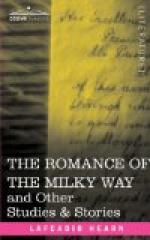IV. SHINKIR[=O]
The term Shinkir[=o] is used in the meaning of “mirage,” and also as another name for H[=o]rai, the Elf-land of Far Eastern fable. Various beings in Japanese myth are credited with power to delude mortals by creating a mirage of H[=o]rai. In old pictures one may see a toad represented in the act of exhaling from its mouth a vapor that shapes the apparition of H[=o]rai.
But the creature especially wont to produce this illusion is the Hamaguri,—a Japanese mollusk much resembling a clam. Opening its shell, it sends into the air a purplish misty breath; and that mist takes form and defines, in tints of mother-of-pearl, the luminous vision of H[=o]rai and the palace of the Dragon-King.
Hamaguri no
Kuchi aku toki ya,
Shinkir[=o]!
Yo ni shirar[’e] ken
Tatsu-no-miya-him[’e]!
[When the hamaguri opens
its mouth—lo! Shinkir[=o]
appears!... Then all
can clearly see the Maiden-Princess of
the Dragon-Palace.]
Shinkir[=o]—
Tatsu no miyako no
Hinagata[33] wo
Shio-hi no oki ni
Misuru hamaguri!
[Lo! in the offing at ebb-tide,
the hamaguri makes visible
the miniature image of Shinkir[=o]—the
Dragon-Capital!]
[Footnote 33: Hinagata means especially “a model,” “a miniature copy,” “a drawn plan,” etc.]
V. ROKURO-KUBI
The etymological meaning of Rokuro-Kubi can scarcely be indicated by any English rendering. The term rokuro is indifferently used to designate many revolving objects—objects as dissimilar as a pulley, a capstan, a windlass, a turning lathe, and a potter’s wheel. Such renderings of Rokuro-Kubi as “Whirling-Neck” and “Rotating-Neck” are unsatisfactory;—for the idea which the term suggests to Japanese fancy is that of a neck which revolves, and lengthens or retracts according to the direction of the revolution.... As for the ghostly meaning of the expression, a Rokuro-Kubi is either (1) a person whose neck lengthens prodigiously during sleep, so that the head can wander about in all directions, seeking what it may devour, or (2) a person able to detach his or her head completely from the body, and to rejoin it to the neck afterwards. (About this last mentioned variety of Rokuro-Kubi there is a curious story in my “Kwaidan,” translated from the Japanese.) In Chinese mythology the being whose neck is so constructed as to allow of the head being completely detached belongs to a special class; but in Japanese folk-tale this distinction is not always maintained. One of the bad habits attributed to the Rokuro-Kubi is that of drinking the oil in night-lamps. In Japanese pictures the Rokuro-Kubi is usually depicted as a woman; and old books tell us that a woman might become a Rokuro-Kubi without knowing it,—much as a somnambulist walks about while asleep, without being aware of the fact.... The following verses about the Rokuro-Kubi have been selected from a group of twenty in the Ky[=o]ka Hyaku-Monogatari:—




